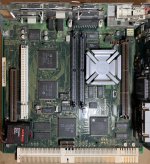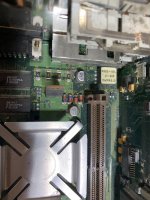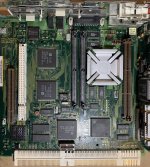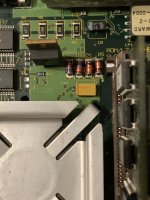It's definitely not related to the capacitor voltage rating. Higher is always safer. Not necessarily always better, as the other characteristics change with the voltage rating like value derating(That 22uf is only 22uF at a certain range of temperature and voltages), and Equivalent Series Resistance. The latter is why I generally don't replace aluminum "cans" with tantalum caps. Tantalums have higher ESR and also when they blow it's pretty for a second, then not so pretty afterwards. Still people use them and they probably work fine under most if not all situations. I just like to use the form factor equivalent Poly-Aluminum caps. They look the same as the aluminums but have a "dry" electrolytic. They are... Well... Expensive. But, nothing's too good for my vintage babies!

Now, if the Q630 doesn't boot in the 5300 chassis, then you likely have two problems! The Q630 and all of the "slow bus" "Power-formas" have roughly the same voltage rail/power requirements. In fact the 52xx/53xx/62xx/and 63xx except for the 6360, were all based on a motherboard design that literally "shoehorned" in the 603 chip where the 68LC040 was. Because of that and a crazy bus split in the architecture, they are horribly slow! The PCI based 5000 and 6000 series are MUCH better. They were designed from the ground up to use the 603e and have the full bus width utilized uniformly. Its soty of like comparing the original 16Mhz Color Classic with the 33Mhz CC2/P550. It "looks" like it's only twice as fast, but because of the bus width, it's about 4 times as fast. And the later 475/575 logic board despite having the same 33Mhz/32-bit bus as the CC2 is I think is quite a bit faster than the CC2. The 5400 series vs the 5200/5300 is more like the comparison between the LC575 and the Original Color classic.
So what am I saying? Don't waste any precious time on that 5300 logic board! Find a PCI based slide in board from a 54/55/64/6500 machine! But first get the chassis working with your Q630 board. I suspect when you crack open the 5300 chassis, you'll find evidence that is was stored in an unworthy environment(Garage, Damp Basement, Hot Attic). The bare metal bits inside aren't designed to be super rust resistant, so if you see lots of rust spots and pitting instead of bright, yet, dull gray metal, theres a good chance that storage killed the whole machine...
I’ve set it aside for now but I’m thinking perhaps the 22uf cap might not be soldered on properly as it’s the cap right next to the CPU.
As for your comments about tantalum caps, most Macs used both electrolytics and tantalums. Tantalum caps are totally safe provided you use good brand ones, don’t overload them, and solder them on properly (not backwards). Nobody is running a vintage Mac 24/7 anymore so the life of a tantalum cap should be fine.
The main difference between tantalum caps and others is they have a frequency and a resistance. I believe the 22uf that I have are 900mohm and 900hz. I can’t remember. But I do know these figures also play into how replacement caps work.
I recapped a Quadra 610 with higher voltage tantalum caps. I believe it used 47uf 16v caps (all 10) and I put on 20v caps. Those caps also had 3ohm resistance. The Q610 booted but everything was slow. Moving the mouse cursor had interruptions and it took forever for the flashing question disk to appear. When it did it only flashed like once every 5 seconds instead of about 1-2 seconds. SCSI didn’t work. I removed all of those caps and put on 47uf 16v 900mohm or 1.2ohm (can’t remember) and it booted up normal right aways. I had another Mac where I put one of these higher rated caps on the SCSI and SCSI didn’t work until I put a lower spec one on.
So cap choice can definitely affect the machine after a recap. These caps I have are for Apple IIe PDS cards and IIci cache cards. Both of those interchangeably used 22uf 25v and 35v so I went with 25v.
In regards to your statement about ditching this board because it will be too slow: I bought this model on purpose. I want to test and compare for myself the speed differences in emulation and native code on a variety of OS versions. This board is the key to doing those tests. I want to determine for myself how bad a 603 chip was in this form factor. I already have 80 vintage Macs I’m not limited to any one machine. I have it all from Plus/SE/Classic through to G5 dual 2.0, and everything in between. Once I can get this working I can pull test data together for all of the models I have.
Lastly, a Lc475 is many times faster than a CC2 because the 475 uses a 68LC040 and the CC2 uses 68030. The CC2 has the wider paths and its processor is also twice as fast. Yes that equates to about 4x as fast. Crazy. But the 040 chips were yet at least 2-4x faster than 030 chips, depending on the model and platform used. My LC475 beats my IIfx in most tests. 40mhz 030 vs 25mhz LC040. I’ve even replaced the LC040 with a regular 040 in one and clocked it to 33mhz. The LC475 platform was quite good, my testing puts an overclocked 475 on par with a Q650/Q800 for all of the tests. So anyone who didn’t need an Internal CD, or NUBUS slots had a good option in 1993/4 with the 475/Q605.
Back to caps, I’m thinking of removing and replacing that 22uf to see if it solves the problem. Alternatively I’ll try and get a different 22uf cap with different specs to try.
Whats strange is it all worked fine before I recapped the 5300 board. Even the monitor/enclosure worked fine with the 5300 board. I hadn’t tried the 630 board in it until I had the failure. The 630 board does nothing in the 5300 case. Not even a click. The 5300 board acts the same in both the 5300 enclosure and the Q630 enclosure. It clicks and immediately shuts off.
As for replacing the caps on a board with caps that look the same, to each their own. I like the look of tantalum caps on the board. They just look like other chips. If you’re trying to be original, you’d use the aluminum electrolytic capacitors instead of modern replacements all together.
I bought a Mac that was sold as recapped on eBay. When I got it I couldn’t be sure it actually was. I mean it seemed like it had blobs of solder on the cap contacts but they looked original. I removed them all and put tantalum caps on. At least I know for sure it’s been recapped and anyone else looking at my Macs will know that too.
And tantalum caps don’t always just blow up when they fail. I have a IIfx that was being slow and crashed a lot. I recapped the board. Worked perfectly after.
From all of the research I’ve done, I’m very happy with replacing my caps with tantalum caps. It took a lot of effort to find the right hz frequency and ohm rating. That may be what I’m facing with this one (the Mac might want a particular frequency or ohms near the CPU).











